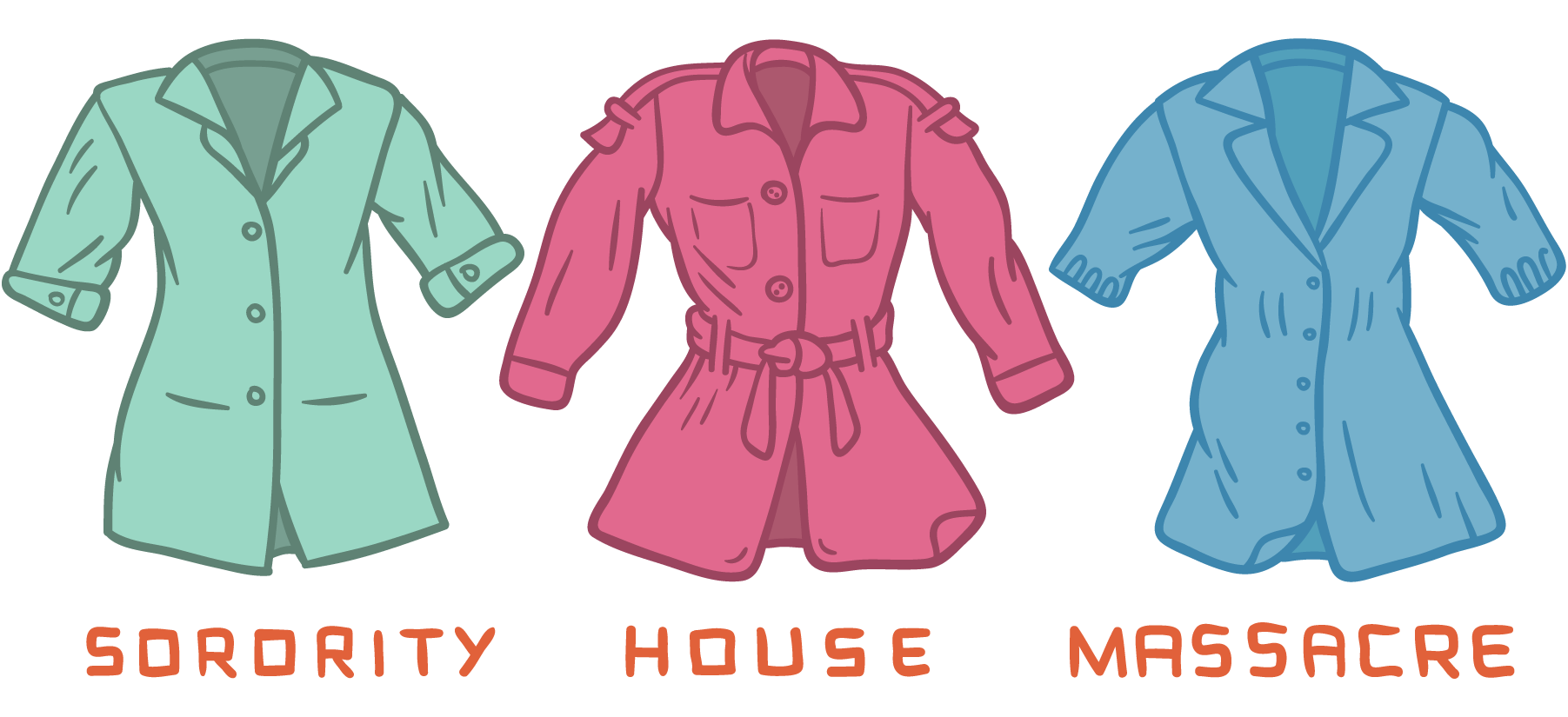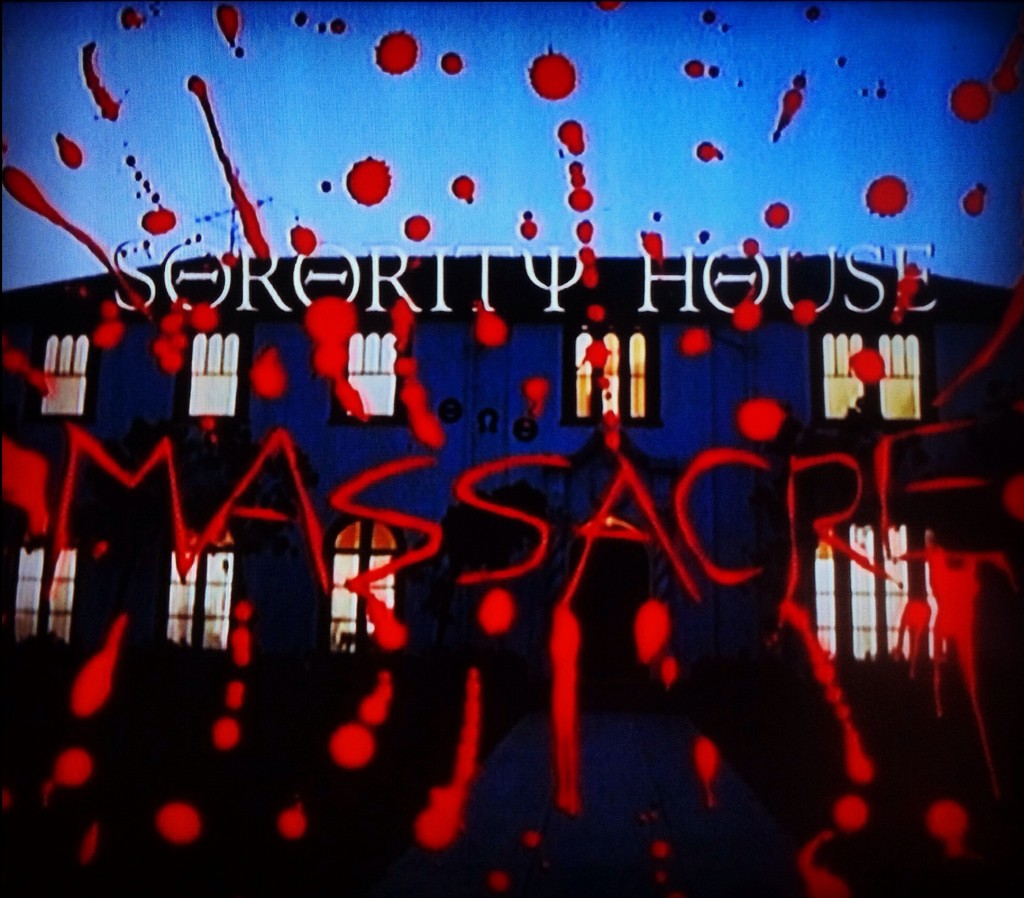The October Diaries: Sorority House Massacre
 Illustration by Max Brown Blurbs by Sean and Christof—
October 3rd, 2014:
Sorority House Massacre
Year: 1986
Director: Carol Frank
Vehicle: Netflix
From Netflix:Â Beth, a girl with a mysterious past, moves into her new sorority.
Sean’s Take:
The horror movie season doesn’t really kick off until you watch your first slasher movie. And now that I’ve just watched Carol Frank’s Sorority House Massacre, I feel like I’ve begun my season in earnest.
It was especially satisfying being able to walk away respecting a movie that bears a name like Sorority House Massacre. It’s titles like these, the more garishly evocative ones, that those who despise the genre use as fuel in their attacks against it. Titles like these make you imagine the worst of the worst. They are easy prey for mockery.
I had felt similar skepticism going into Slumber Party Massacre a few years ago, because of that film’s title, and that skepticism ended up being completely unwarranted. Carol Frank actually worked as an assistant director on Slumber Party Massacre before making her directorial debut with this one (also penning the script) so she is familiar with the subtleties of a good massacre. I think I ended up respecting both of these films so much more than I anticipated because they clearly respected themselves.
For instance, a good way to tell if a horror movie is really clicking is if you, for-reals, don’t want any of the characters to die. This was the case with our leading ladies. The handful of sorority sisters that anchored the plot, and the handful of men they kept around as dates, all showed respect for one another and, by the end, each had developed their own unique personality – even Jeff, the boyfriend of one of the sisters, who decides to go off rafting with his friends, vanishing from the film in the process, instead of hanging out for the massacre. Jeff expresses his desire to go rafting honestly and openly with is gal, proving he belongs in a healthy relationship and, as a reward, he is spared participating in the massacre.
The characters were also blessedly given the gift of intelligence. This attribute is a rare commodity, scarcely found in the behavioral patterns of many of the leads who go toe-to-toe with menacing figures in these types of films. It was greatly satisfying to see characters make smart decisions when faced with terrifying choices. If the psycho villain was dangling from a window, the sisters had the smarts to at least bang on the madman’s fingers.
And what a strange, perfectly bland, perfectly terrifying, villain Sorority House Massacre featured. This was the villain of my youth – the type I conjured as the most scary thing I could muster to frighten myself before going to sleep as a kid. I wasn’t nearly as scared of a monster that might be living in my closet, what scared me the most as a kid was this breed of killer: a white guy with a mean face and a hunting knife. He doesn’t hide behind corners and vanish out of your peripheral vision just as you turn, instead he jogs toward you, stabs you quick in the gut and keeps his heart rate up by continuing his jog toward the next kill. There’s an urgency that insults the hesitation of the cat-and-mouse style killers. This type of insatiable murder momentum is very scary to me. Probably because it seems more believable than the methodical, taunting, method. I know that in real life white guys with mean faces often kill people, and they probably use hunting knifes with a sense of urgency at least every now and then.
There’s a great moment about a third of the way in that encapsulates the joy of this movie. It gives you what you expect from an 80’s movie that takes place in a sorority house – a montage featuring ample nudity* and wardrobe changes. What elevates the material above crassness is the lived-in banter and believable conversations that surround the montage. The montage feels earned
It had some great stylistic flourishes despite a relatively cheap production quality, and a firm control over the editorial side of things, making the proceedings zip right along and wrap-up in breezy 74 minutes (generous in its restraint). This is the consensus favorite of the month thus far amongst our regular living room audience.
*Growing up, nudity in films was referred to as “allowance†amongst our core group of friends. The teenage-boy logic was as follows: watching a movie was the chore and any bare breasts was the allowance we received for the “work†we put in as viewers. Sorority House Massacre gave good allowance.
Christof’s Take:
You might expect, as I did, that this would be an incredibly flimsy, fun-because-it’s-so-bad kind of romp (and there’s still some of that, for sure), but considering how much cheap trash is out there, this was a wonderful surprise that turned out to be a bit of a popcorn masterpiece.
The acting comes off as clunky, but it’s a low-budget horror film from the 80’s; the acting either should be a little clunky or should be adequate in a clunky universe.. It’s not apparent early on how much of what is intentional, because the production value is low, but you slowly learn that the film’s reality is bent with self-awareness.
It’s a fairly unabashed “rip-off†of John Carpenter’s Halloween in certain respects. For instance: a group of young women are stalked by a man who broke out of a ward where he was locked up for having killed most of his family in his youth, except for his sister, who he’s after now. So, yeah: you might find that threat a touch familiar.
What this has that Halloween very much so lacks is a base of (comparatively) strong female leads.
Horror cinema is notorious for presenting poorly drawn characters, be they male or female, but the fact is that a lot of horror either neglects female characters or presents them as fundamentally handicapped by gender, rendering they absent or useless – in Sorority House Massacre, they are neither. These are characters with at least some amount of depth to them: they are not stereotypically catty, they are not void of reasoning or intellect, they are not incapable of generating ideas and thoughts, and they are not dependent on the male characters (who are not nearly as developed [which should be the case as this is not a movie about them] and yet the boys are not portrayed as dipshits, nerds, jocks, or completely unsympathetic asshole boyfriends). Most importantly, the ladies do more than run away and fumble with doorknobs while looking over their shoulders and scream-crying.
Watching this movie, knowing that people must get slashed for it to qualify as a slasher, I was kind of hoping no one would get hurt. Maybe our silent, maskless creep-fest of a killer would get arrested and these polite folks would have more time to hang out. October doesn’t permit such things, but still: it was refreshing to not have even one character who is such an asshole that you just know or even hope they die first.
Maybe this is a stab in broad daylight, but I think these differences might have everything to do with the film’s female writer-director, Carol Frank, who self-awarely makes interesting choices for the grade of horror in which she’s working.
The majority of token “sexploitative” aspects are kept pretty well quarantined to pretty much one scene, which is a fun, silly montage of the gals trying on a sorority sister’s clothes while she’s out – pretty broad strokes here, but again, it’s tasteful and respectful when compared to other horror films with similar titles, which are too often soft-core porn masquerading as horror. (From what I’ve read, this is a good description of the sequel, which was directed by a man.) The scene features gal-pal nudity that is completely unnecessary but also treated commonplace and not hyper-sexualized; it never leads to topless pillow-fights or any other ridiculous stereotypical male fantasy.
I’m impressed with and even jealous of the self-reflexive aspects of the film. Carol Frank achieves some symbolic depth (and a pretty gnarly sense of foreboding) throughout, but especially in dream/vision sequences, and then she has fun by making her friendly and welcoming cast interpret the new pledge’s dreams. One character pulls out her “book on symbols†and declares, “Let’s crack this baby!†And then they make it unequivocally clear that the choices in this movie are in fact choices.
If there’s any doubts about the filmmaker’s intentions at having fun with the genre and the form, they are cleared away after a classic false scare happens – one character spooking another for fun. Immediately after, they sit down in front of a TV that’s showing a movie where someone gets a false scare by a cat lurking in a closet. This joke is continued later, when someone sits down and the TV is showing an image of a person watching a TV.
This shrewd playfulness is a heavy-double-wink that confirms that Carol Frank knows exactly what she’s doing. Don’t judge a movie by its cover, or even its title: Sorority House Massacre is a psychological feminist metafictive slasher flick that picks Halloween’s pocket and then points and giggles at what it finds.
If Sorority House Massacre is trash, then it’s trash-literature.


Excellent!!